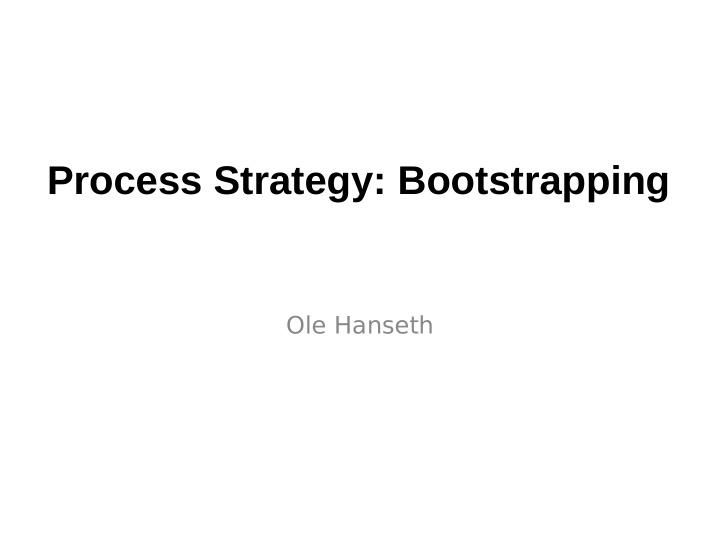



Process Strategy: Bootstrapping Ole Hanseth
Infrastructure evolution • Evolution – Adoption – Scaling – Innovation: of, in, on – Harmonization/restructuring/consolidatio n – Crumbling/fragmentation • Aims => process strategy • Appliance or generative II?
A self-reinforcing installed base ).
Granovetter/Schelling model • Ex: Dying seminar, crossing a street • Our preferences depends on others actions • Preferences vary • Processes depends on distribution of preferences • Small changes may have large effects
Challenges • Doesn’t take off: No value for few users – everybody waits for the others. • If it does – it becomes autonomous: – Lock-in – Develops in undesired directions – Increases the problems one tried to solve (reflexive/self-destructive)
Design strategies 1. Specification driven/«Big Bang» 2. Prototype/pilot 3. Living Lab/Installed base cultivation • 2 fail, one succeds
Strategies (some ideas) • Flexibility – Minimalism, modularisation (loose coupling) • (=gateways) – Generativity (end-2-end + programmbility) • Use the installed base as resource – Bootstrapping • Build upon existing installed bases • Build an installed base (users before functions) – Avoid lock-ins: Gateways
Growing networks • “Manipulating” preferences • Through design .. • Arranging users • Bootstrapping
’Bootstrapping’ • Enclocypedia: ’She bootstrapped herself to the top’ – to manage on one’s own • Lifting yourselves by your hair • Booting a computer • Implementing a programming language • Language learning • Making a tool/network by means of the tool/network • ”Deliver a better today, rather than promise a better tomorrow”. • Late adopters adopt because the others have already • First adopters must adopt for another reason
Identifying and arranging preferences • Multi-dimensional • Personal, individual • Use areas and situations • Technological aspects • Coordination/governance structures • Arranging preferences and dimensions (dynamically)
Bootstrapping Network Technologies • Select motivated and knowledgeable users • Simple, non-critical, non-complicated use areas where no large organisational changes are required. • Select simple, relatively cheap and well supported technical solutions. • Users first, then functionality/technology
Individual/personal preferences • Motivation, attitudes towards technology • Knowledge about technology
Aspects of use areas and situations • Resources • Benefits of communication within a small network • Critical/non-critical activities • Complexity of tasks and work practices • Organizational changes needed
Aspects of technology • “Distance” between users and designers/vendors • complexity • costs • flexibility • “allied with the future”
Coordination and governance • Structures and institutions have to be established (bootstrapped) • “Standardization bodies” – Technology (protocols) – Work practices/procedures (protocols) • (The Internet is an example to learn from in this respect as well)
Design strategy • Start with – simple, cheap, flexible solution – small network of users that may benefit significantly from improved com. with each other only – simple practices – non-critical practices – motivated users – knowledgeable users
Bootstrapping design principles 1. Design initially for usefulness 2. Draw upon existing installed base 3. Expand installed base by persuasive tactics
Boostrapping algorithm 1. Repeat as long as possible: enrol more users 2. Find and implement more innovative use, go to 1 3. Use solution in more critical cases, go to 1 4. Use solution in more complex cases, go to 1 5. Improve the solution so new tasks can be supported
MyHealthRecord Communikasjon between patients and health care insititutions
2002-200 2005-200 2009-201 4 9 2 Phase I Phase II Phase III Conceptual design Initial experiences Consolidation • 2005: Creation of unit for • MyRec is contacted by • 2002: Design of MyRec as ”research and patient departments and patient component in the Clinical services” (MyRec), new unit organizations Portal. manager, new member •development of a number of • Clinical portal prioritise hired modules addressing specific existing fragmentation of IS •2005: first functional problems of hospital-patient in the hospital, MyRec not version implemented communication and focus on further included . solving concrete specific •2005: secure messaging •2003: first Initial sketches problems. designed and implemented as independent solution with • development of a number of • Design of Request-change focus on providing trusted general modules. of appoitments services and information and access to diversification in • development of modules document from hospital open/closed services according to a generic logic for systems. re-use. • Benefits • 2004: first mockups with • wider implementation of generic various suggested • Some functionalities functionalites functionalities dismissed • participation in EU project • 2004: idea to design of • 2008: change of security secure messaging service to • Other hospitals take MyRec into solution to a more user address the illegal use of friendly one use email in patient-hospital communication
MyHealthRecord – 1st design
2nd version • Stand-alone infrastructure – iKnowBase platform – A few basic services • Secure logon • Secure email – A few specialized services
3rd version • Emergning • Tools and services for diabetes patients • ”plaform for disease management”
Evolution • Innovations – Of: 3 versions – In: BankID as security system – On: specialized services, generification, a new layer emerging • Architecture: 3 versions, ”experimental architecting” • Process strategy: experimental development, early use (bootstrapping) • Governance regime: small, independent team (”under the radar”)
Mobile payment systems • Google Wallet, Apple Pay, ValYou, .. • NFC technology • Intergations: handsets, id/security, banks, shops, credit card companies, .. • User adoption, … • New bank/finance institutions?? • Regulatory issues?
Recommend
More recommend